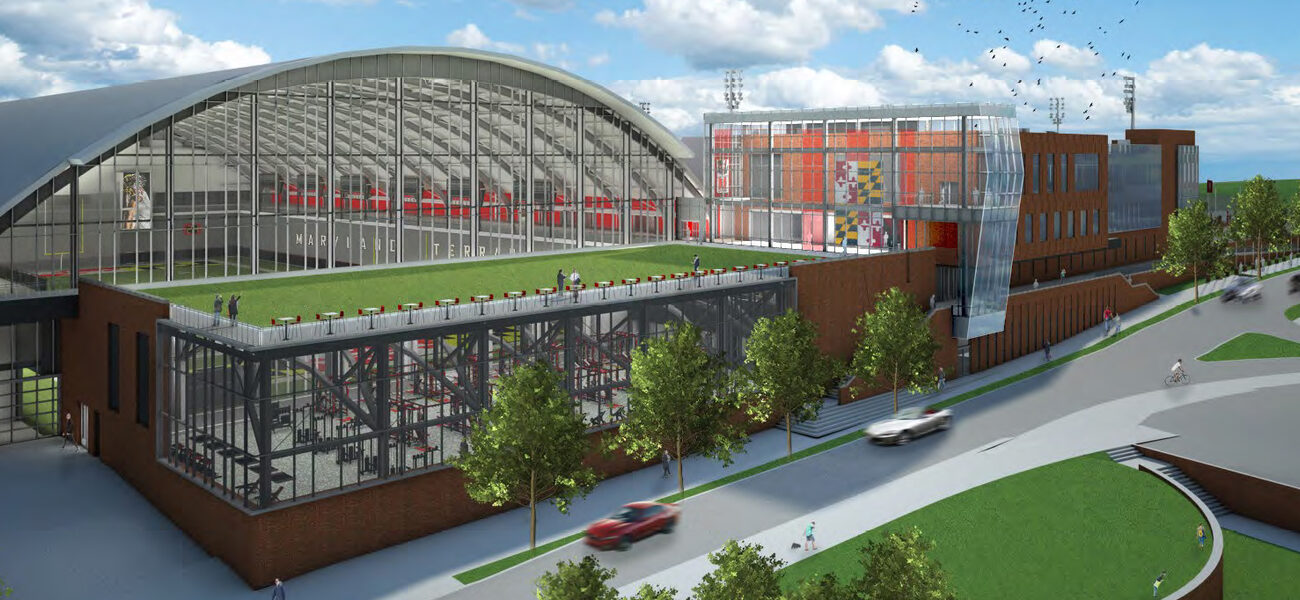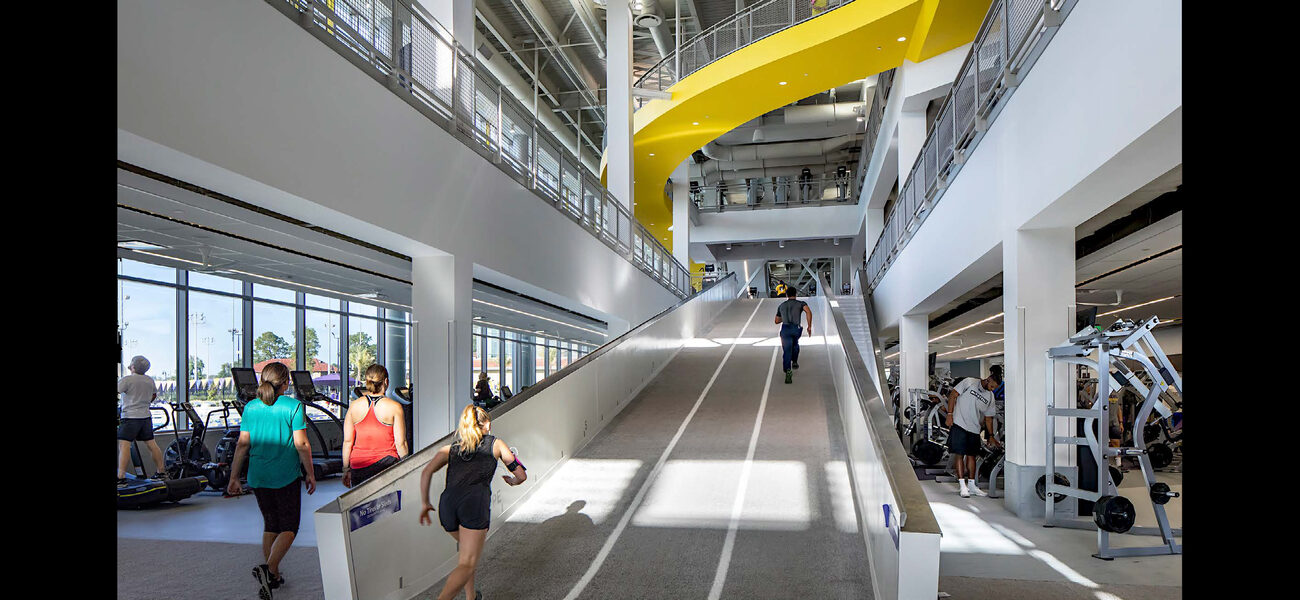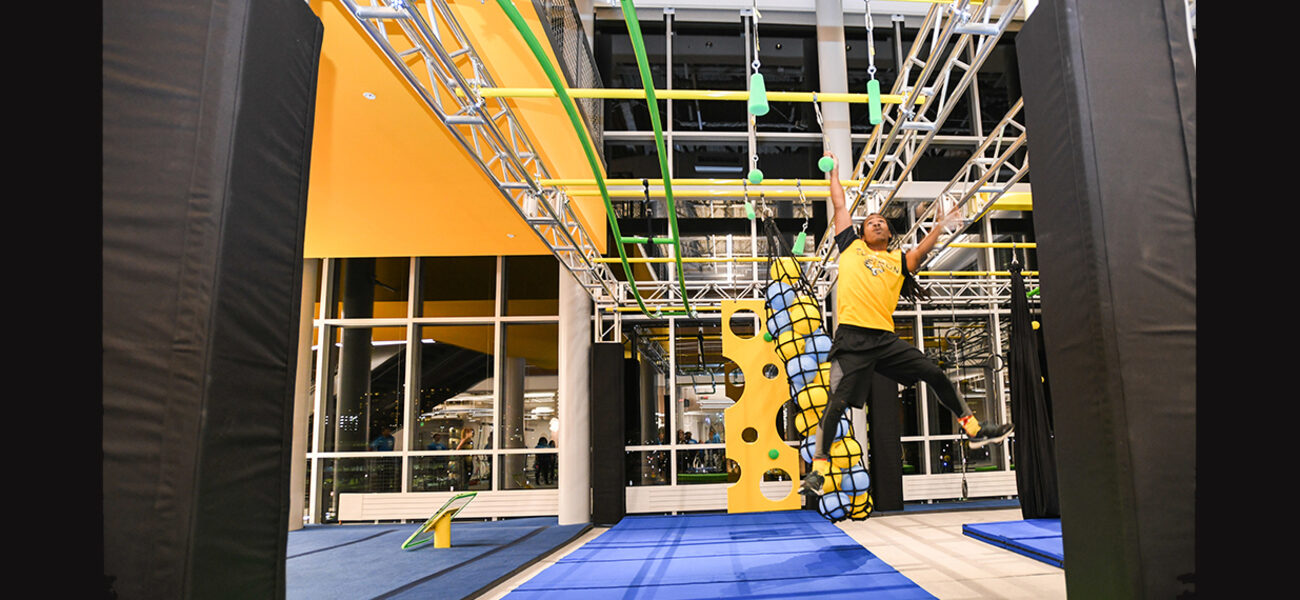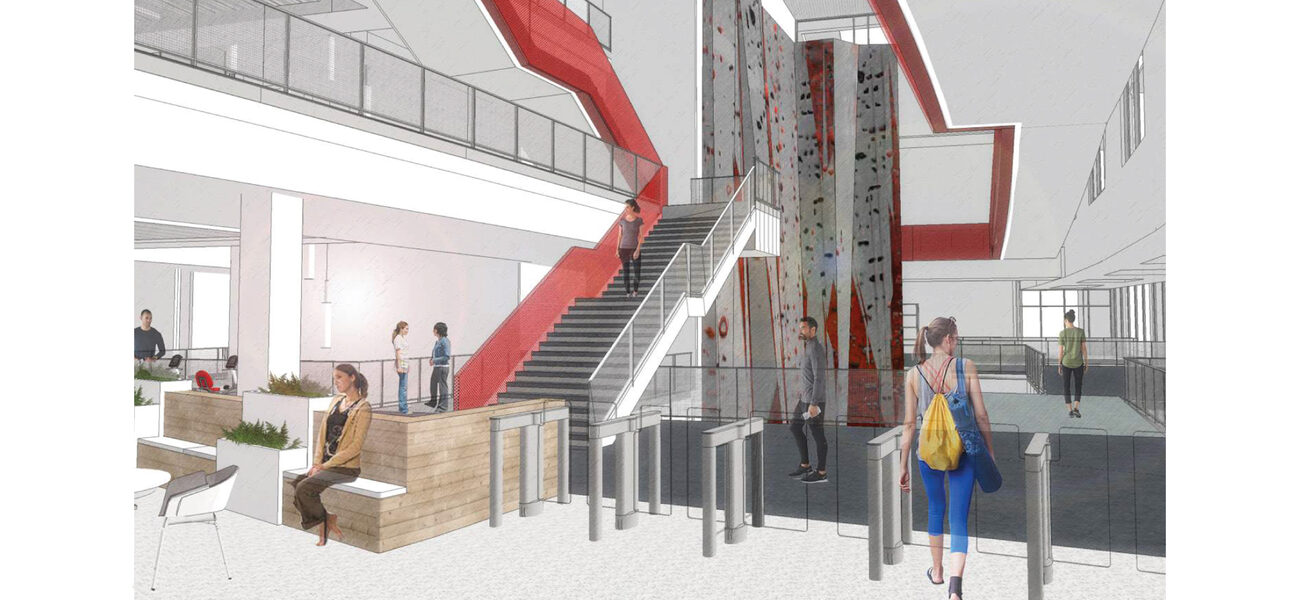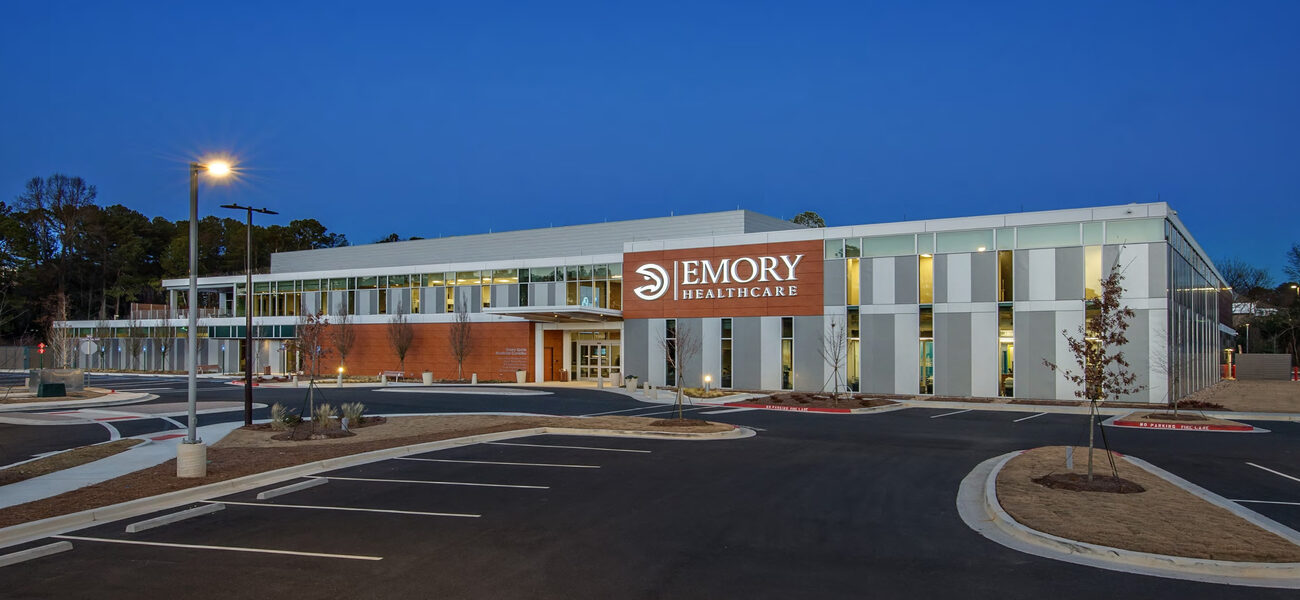An emerging new model for hybrid translational healthcare facilities combines scientific research with university and professional athletic programs to increase community engagement and student wellbeing. From integrating sports training facilities with medical clinics and applied research, to incorporating fitness gyms, running tracks, and rock-climbing walls into student lounges and public spaces, the combination of athletics and recreation with other programs offers an innovative vision for academic facility design.
One example of professional sports and medical research coming together is Emory Healthcare Courts—which is part of the Emory Healthcare Sports Medicine Complex—a collaboration among Emory University, Emory Healthcare, and the Atlanta Hawks professional basketball team. This relationship gives Emory Healthcare the brand exposure and fundraising ability that comes with providing medicine and rehabilitation services to a high-profile NBA team, while giving the Hawks world-class healthcare services and medical professionals collocated in their training facility. This means they can get rapid personalized analysis of nutrition and metabolic data to ensure players maintain optimal performance while also giving them private treatment that keeps player injuries and health issues out of the media spotlight.
“We are in a transformational period in terms of how we are thinking about and programming spaces and the way we are getting funding for infrastructure,” says Randy Kray, director of science and technology for HOK. “With these new hybrid facilities, we are finding that it is no longer just about the undergraduate STEM teaching laboratories. It is no longer just about research space or classrooms. It’s about the whole student experience and the researcher and faculty experience. It is about the notion of designing better places for human performance. It is about getting more for our infrastructure buck and combining learning, research, science, application, and commercialization to change the world.”
A notable recent hybrid facility is Notre Dame’s newly opened Duncan Student Center, which targets the integration of fitness and student wellness programs with social interaction and community spaces. In addition to study, meeting, dining, and activity spaces, the building features a fitness gym with an extensive array of equipment, an indoor running track, and a 37-foot-tall rock-climbing wall that rises dramatically out of the lounge adjacent to the central staircase.
“One of the questions we’re trying to address in these types of facilities is, how can fitness and recreation be a catalyst for change and wellness?” says James Braam, director of recreation and wellness for HOK. “We know that the social aspect of coming together and group exercise have tremendous benefits. So we’re looking at how these types of lounge spaces, hybrid spaces, and crossover spaces can make a difference, if we design them right. There are often 2,000 to 4,000 visits a day to some of these buildings, and most of those visits are happening in the evening. It’s hard to imagine that students can study in a Starbucks. But studying in a recreation and wellness center is now the norm. And we are finding that these buildings have an opportunity, an obligation even, to do more than just support recreation. It is not just a gym. It is not just a fitness center.”
Carmichael Wellness and Recreation Center
North Carolina State University brought a hybrid approach to the remodel of the Carmichael Wellness and Recreation Center. The updated facility will connect the gym and recreation center to create one primary entrance that serves as a centralized campus hub for recreation and wellness.
“We are really shifting what we do in the Wellness and Recreation department and why we do it,” says Eric Hawkes, executive director of wellness and recreation at North Carolina State University.
“We know that our students are coming to campus with significant mental health issues, in terms of increased stress, anxiety, and depression. This isn’t going to change. So we have to be part of the solution and look at how we can create a culture of wellness on campus.”
The remodel and addition will add a new 12,000-sf fitness facility, called the Thrive Center, that features functional training space, strength and conditioning zones, performance studios, and small group training spaces, as well as a climbing tower, running track, wellness education spaces, and a teaching kitchen. New office space in the building will provide an open, flexible floorplan that facilitates collaboration and social interaction across departments.
“Now we can invite our wellness and wellbeing partners from across campus to hotel office with us. They can come over and bring their laptops, set up a space, and start working with us whenever they want. The idea is that this space should serve as a home for any of our campus partners or any of our specific wellness outreach efforts,” says Hawkes.
Conference rooms, huddle rooms, and meeting rooms used by administrative staff during the day will be used for wellness coaching and other programs in the evenings, serving hundreds of students.
“I am in the division of academic and student affairs; my colleagues who run the student union are in campus enterprises; the other groups are in business services. We all live in our thing. And we have to fight those silo lanes, because, at the end of the day, students just call it NC State. They don’t care about our labels. And I think this bigger idea of wellness helps us integrate all of our services. Again, the idea with the Thrive Center is that we want this space to be a home for any of our campus partners or any of our specific wellness outreach efforts to let our students know what resources we have available to them. We know that physical activity and exercise absolutely make a difference, but it’s not just about physical activity for us anymore. Now we know that developing relationships and supporting everybody is also important,” says Hawkes.
The New Cole Field House
When the University of Maryland became part of the Big Ten Conference, it was important that they upgrade their aging football facilities to stay competitive. So the university took the opportunity to bundle the new athletic complex with state-of-the-art facilities for translational research, engineering, and applied medicine. The resulting Center for Sports Medicine, Health and Human Performance will bring an interdisciplinary team approach to high-performance sports medicine and occupational health by combining neuroscience, bioengineering, and advanced imaging technology with strategic entrepreneurship to solve real-world problems and create market-viable products.
Expanding on the historic Cole Field House—which is prominently located on a hill at the center of campus—the new football training complex will also house an orthopedic clinic and the Center for Nervous System Injury and Neurosciences. The facility will bring together a number of previously dispersed programs, including the university’s Public Health department, which focuses on biomechanics and human performance. The human performance labs will support the university’s football team, but programs will also cater to other student athletes, as well as first responders, firefighters, and police officers.
“Brain research has become a hot topic in the past three to five years. Because of that, there is a significant focus on the many different types of imaging required to study the brain” says Joe Popp, vice president at CannonDesign. “The imaging lab corresponds with the needs of the orthopedics lab. Parallel with orthopedics are the prosthetics and robotics research labs, as well as sleep labs, psychological evaluation labs, and engineering labs supported by brain imaging. If it is related to human performance and the human body, it is pretty much linked to this facility.”
The facility will contain a wet lab, a PET/CT scanner, and two MRIs, as well as radioactive suites and other support spaces. Notable components include a 30-meter motion-capture track with embedded force plates. This allows for three-dimensional gait and balance analysis of individual players. Another 100-meter outdoor track is equipped with infrared sensors.
“Our attitude with training centers is that every place where an athlete trains is a place where research can, and should, be done,” says W. Kenneth Wiseman, design principal at CannonDesign. “So every piece of a sports facility should be plug-and-play and made available to the researchers; then it is up to the researchers to determine whether they can take advantage of it.”
The Mild Traumatic Brain Injuries (MTBI) program will work with human subjects to study EEG caps, skull caps, and other ways of imaging the brain that go beyond MRI and CT. Since the engineering department is in the same facility, a wide range of instruments, including doppler and functional ultrasound, will be studied based on the different instrumentation and mechanics of the device.
“You can imagine how all these groups of people who don’t normally work together will be able to find new opportunities they wouldn’t normally find without bumping into each other every day,” says Popp.
Since the NCAA has a strict limit on the amount of time athletes and coaches in Division I football can spend together, time and distance studies were conducted to minimize travel between the training spaces, locker room, and playing field. The layered, four-floor building was adjusted accordingly to optimize proximities and enable rapid movement from the locker room through a tunnel to the playing field. While cross-discipline interaction was a major priority, security was also an issue, as it required the football program to stay in a secure, siloed environment. While there’s abundant natural daylight in the building, the windows overlooking the training field are frosted glass to prevent viewing or recording.
Additionally, University of Maryland alumnus, Kevin Plank, owner of Under Armour®, was a significant donor and cultural driver in the development of the new facility, establishing the Academy of Innovation and Entrepreneurship in the building. The business academy will teach young entrepreneurs how to take newly developed devices and emerging technologies into the marketplace.
“The orthopedic clinic also serves the region, so you or I could go there and see the same doctors that are taking care of the football team or the women’s basketball team and the rest,” says Wiseman.
What’s Next
A common theme with this new breed of hybrid facilities is that they are promoting a more integrated approach to campus life, with an emphasis on recreation, athletic activity, human performance, and applied health science.
“We’re seeing that a focus on fitness and wellness is something that can bring a facility together. We’re also seeing an increase in the desire for more healthy food options and anything else we can do in terms of getting students off energy drinks and back to social engagement,” says Braam.
Another common theme is integrating high-performance recreation spaces into academic social environments, student centers, and lounges to inspire and engage students.
The new Student Recreation Complex at Louisiana State University (LSU) features a turf-lined sprint incline that winds through the space like an LSU Tiger tail, connecting the track to more than 40,000 sf of cardio and weight room space, a 38-foot-high climbing wall, and a functional fitness area.
“Is it crazy to think that we could have a dedicated skate park? Or a warrior obstacle course? Well, Towson University just installed an American Ninja Warrior course in one of their new facilities, so it is being done,” says Braam.
By Johnathon Allen
| Organization | Project Role |
|---|---|
|
CannonDesign
|
Architect
|
|
HOK Science + Technology Group
|
Architect
|
